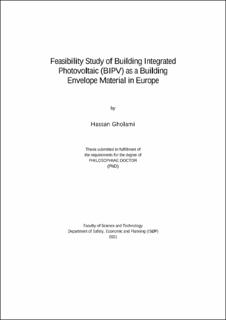| dc.contributor.advisor | Røstvik, Nils Harald | |
| dc.contributor.advisor | Müller-Eie, Daniela | |
| dc.contributor.author | Gholami, Hassan | |
| dc.date.accessioned | 2021-09-30T13:22:04Z | |
| dc.date.available | 2021-09-30T13:22:04Z | |
| dc.date.issued | 2021-09 | |
| dc.identifier.citation | Feasibility Study of Building Integrated Photovoltaic (BIPV) as a Building Envelope Material in Europe by Hassan Gholami, Stavanger : University of Stavanger, 2021 (PhD thesis UiS, no. 608) | en_US |
| dc.identifier.isbn | 978-82-8439-031-4 | |
| dc.identifier.issn | 1890-1387 | |
| dc.identifier.uri | https://hdl.handle.net/11250/2786695 | |
| dc.description | PhD thesis in Risk management and societal safety | en_US |
| dc.description.abstract | Buildings play a vital role as regards the energy efficiency of urban areas since they are responsible for a significant portion of the energy demand of urban areas. In Europe, building energy use accounts for 41% of the total energy consumption of the cities [1]. Urban energy transition has recently come about by intensifying the endeavour towards promoting distributed or decentralised energy generation (DG) and realign the energy production and consumption of buildings.
One of the leading solutions which can be of great assistance to contribute towards such an approach is building integrated photovoltaic (BIPV) systems. BIPV is a PV system on the building skin serving as both a building envelope material and a power generator. An alternative that is not covered here is PV systems nearly – in the landscape or garden. There is a tendency currently in the market to use BIPV systems in the part of the building skins with the highest incident solar radiation and, therefore, higher electricity production as an output. These areas in the northern hemisphere are roof and south façade. However, employing other facades and areas of building skins also results in many advantages. The possibility to achieve zero energy buildings (ZEB) or even plus energy building goals, using different facades and orientations of buildings to have a distributed electricity generation during the day, and the system's contribution in reinforcing the energy performance of the building skin are some advantages. To place PV modules so that they deliver energy when the energy need in the building is highest is also of importance as it reduces the need for storage.
Therefore, this thesis focuses on building integrated photovoltaic systems (BIPV) and their feasibility as a building envelope material in Europe. The main research question is defined as follows:
Is the BIPV system as an alternative for the more usual building envelope materials feasible for the entire skin of buildings in Europe?
The goal is to investigate the technical and economic aspects of such a solution in two steps. Finally, the project seeks to briefly discover the potential and challenges of such a solution in the energy transition of cities.
Both qualitative and quantitative methodologies are employed in this project, and most of the analyses are based on the data obtained from the Photovoltaic Geographical Information System (PVGIS) and the Surface Solar Radiation Data Set - Heliosat (SARAH) dataset.
The results are expected to help the end-users, architects and urban planners to acknowledge the BIPV system as a suitable option for the building skins in Europe and steer governments or decision-makers to promote the technology by rational subsidies and incentives (where it is needed). This can contribute towards making cities as well as more rural areas into “power stations”. | en_US |
| dc.language.iso | eng | en_US |
| dc.publisher | University of Stavanger, Norway | en_US |
| dc.relation.ispartofseries | PhD thesis UiS; | |
| dc.relation.ispartofseries | ;608 | |
| dc.relation.haspart | Paper 1: Gholami, H., Røstvik, N.H. (2020) Economic analysis of BIPV systems as a building envelope material for building skins in Europe. Energy, 204, 117931, https://doi.org/10.1016/j.energy.2020.117931 | en_US |
| dc.relation.haspart | Paper 2: Gholami, H., Røstvik, N.H. (2021) Dataset for the solar incident radiation and electricity production of building integrated photovoltaics (BIPV) system on the northern\southern façade in dense urban areas. Data, 6(6), 57. https://doi.org/10.3390/data6060057 | en_US |
| dc.relation.haspart | Paper 3: Esmailian, E., Gholami, H., Røstvik, N.H., Menhaj, M.B. (2019) A novel method for optimal performance of ships by simultaneous optimisation of hull-propulsion-BIPV systems. Energy Conversion and Management, 197, 111879, https://doi.org/10.1016/j.enconman.2019.111879. This paper is not included for copyright reasons. | en_US |
| dc.relation.haspart | Paper 4: Gholami, H., Røstvik, N.H. (2021) The Effect of Climate on the Solar Radiation Components on Building Skins and Building Integrated Photovoltaics (BIPV) Materials. Energies, 14(7), https://doi.org/10.3390/en14071847 | en_US |
| dc.relation.haspart | Paper 5: Gholami, H., Røstvik, N.H., Müller-Eie, D. (2019) Holistic economic analysis of building integrated photovoltaics (BIPV) system: case studies evaluation. Energy and Buildings, 203, 109461, https://doi.org/10.1016/j.enbuild.2019.109461 | en_US |
| dc.relation.haspart | Paper 6: Gholami, H., Røstvik, N.H. (2021) Levelised Cost of Electricity (LCOE) of Building Integrated Photovoltaics (BIPV) in Europe, Rational Feed-In Tariffs and Subsidies, 14(9), https://doi.org/10.3390/en14092531 | en_US |
| dc.relation.haspart | Paper 7: Gholami, H., Røstvik, N.H., Kumar, N.M., Chopra, S.S. (2020) Lifecycle cost analysis (LCCA) of tailor-made building integrated photovoltaics (BIPV) façade: Solsmaragden case study in Norway. Solar Energy, 211, pp. 488-502, https://doi.org/10.1016/j.solener.2020.09.087 | en_US |
| dc.relation.haspart | Paper 8: Gholami, H., Røstvik, N.H., Steemers, K. The contribution of building integrated photovoltaics (BIPV) to the concept of nearly zero-energy cities in Europe: potential and challenges ahead. Under review in Solar Energy. | en_US |
| dc.rights | Copyright the author | |
| dc.rights | Navngivelse 4.0 Internasjonal | |
| dc.rights.uri | http://creativecommons.org/licenses/by/4.0/deed.no | |
| dc.subject | risikostyring | en_US |
| dc.subject | samfunnssikkerhet | en_US |
| dc.subject | energi | en_US |
| dc.subject | solenergi | en_US |
| dc.title | Feasibility Study of Building Integrated Photovoltaic (BIPV) as a Building Envelope Material in Europe | en_US |
| dc.type | Doctoral thesis | en_US |
| dc.rights.holder | ©2021 Hassan Gholami | en_US |
| dc.subject.nsi | VDP::Teknologi: 500 | en_US |

